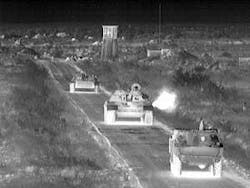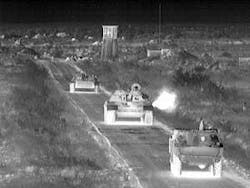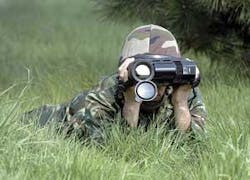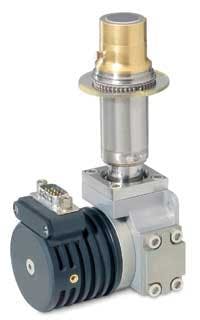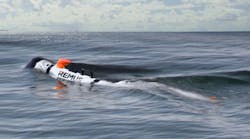By Ben Ames
ORLANDO, Fla.-Military users of infrared scopes will have to wait another five or ten years to see full production of third-generation scopes.
In the meantime, manufacturers are using new technology to improve today’s second-generation scopes. These “2.5-generation” devices offer lighter weight, smaller size, and better power efficiency than older second-generation devices.
In March, designers at Sofradir in Chatenay-Malabry, France, showed off improvements to Venus and Pluton, both 2.5-generation infrared detectors based on an alloy called MCT for mercury cadmium telluride.
By changing the blend of the mixture, they can tune it to detect a range of wavelengths from 0.8 to 15 microns. Some users prefer a scope tuned to pick up 8 to 12 microns-the peak emission of humans-while others need a scope optimized to pick up the much hotter signature of jet engines, says Phillippe Bensussan, president and CEO of Sofradir.
The company has sold 15,000 units of Pluton, more than 50 percent share of the market, he says. He demonstrated the products at the SPIE Defense & Security Symposium trade show in Orlando, Fla.
The upgraded version will decrease power consumption while trimming size and weight-crucial metrics for battery-reliant applications like infrared goggles and hand-held detectors.
Sofradir makes the electronics, and buys a vacuum and display from suppliers. High-end, cooled infrared scopes must operate at 85 degrees Kelvin to avoid picking up their own heat signatures. In this design, Sofradir saved weight and efficiency with a new cooler from Thales Cryogenics. The RM2-Xi weighs 9.6 ounces and delivers high thermal efficiency and low battery draw.
Since their widespread introduction in the 1970s, infrared detectors have quickly spread to use in industries from military and security to environmental monitoring, science, and space.
By the early 1990s, second-generation FLIR (forward-looking infrared) cameras offered users twice the target acquisition range, detecting enemy vehicles through darkness, smoke, and dust almost four miles away.
Now “2.5-generation” technology improves infrared performance in wider weather conditions, better identification of targets, smaller size, and better reliability. It will also bring attributes such as smaller pixel pitches, larger formats, multicolor detectors, and active imagery detectors.
These newer scopes gain high resolution by using large arrays of infrared-sensitive cells. The current challenge is to keep size and cost down by shrinking that array, and decreasing the pixel pitch of each sensor.
Designers can also cut weight by choosing an uncooled infrared scope, which does not require cryogenic vacuum coolers, but sacrifices sensitivity.
This current technology should serve military needs until manufacturers deliver third-generation scopes around 2010 to 2015, say Sofradir engineers.
Third-generation scopes will offer longer identification range, fewer operating constraints, and lower price. Manufacturers will achieve that by using more pixels, multicolor displays, increased frame rates, and preprocessing chips on the focal plane, according to Sofradir.
Better screens
Another major advance in infrared vision is improved displays.
Designers at Kopin Corp. in Taunton, Mass., build a line of CyberDisplay products for this application, ranging from their 0.59-inch diagonal, 800-by-600-pixel SVGA to the 0.44-inch, 640-by-480-pixel VGA.
The new VGA screen delivers ultrahigh contrast, so the ratio of difference between black and white colors is no longer 100-to-1 but 1,000-to-1, says Kopin Vice President Michael Presz.
In a demonstration on the show floor, the screen showed a noticeably sharper image with this improvement. It also offers a wide and symmetrical field of view, limited only by the viewer’s distance away and the height of the bezel itself.
Kopin engineers achieve this performance by shrinking the pixels to a tiny size, Presz says. The new VGA screen uses pixels just 14.1 square microns in size. Each is cut into three strips so the effective pixel size is really 4.7-by-14.1 microns.
Later in 2005, the company will deliver three new products for thermal viewing, image-intensified viewing, or image fusion-a combination of the two.
The CyberDisplay SXGA will offer a 0.97-inch diagonal screen with 1280-by-1024-pixel resolution, greater than HDTV (high-definition television). This screen can display image-fusion signals while extending battery life.
Kopin engineers will also deliver the Multi-Domain Vertical Alignment (MVA) screen for both image-intensified and thermal vision, and the Auxiliary Targeting Viewer (ATV) for thermal-imaging weapon sights.
Soldiers can use the ATV unit to see around walls, by peering through a helmet-mounted screen while aiming the weapon sight around a building’s corner. And reporters on a show floor were able to use the ATV to peek into neighboring booths.
Image fusion
One of the biggest initiatives in the industry is the Enhanced Night Vision Goggle. U.S. Army leaders want a scope that can combine night vision with heat detection. In April they awarded a five-year, $560 million contract to ITT Industries Night Vision in Roanoke, Va., to build it.
The Enhanced Night Vision Goggle (ENVG) optically combines an image-intensification image and next-generation infrared image, so the soldier can have better target detection and identification.
For the contract, ITT offered its own image-intensification products, and partnered with Raytheon for the infrared components.
The Army’s Research, Development & Engineering Command Acquisition Center, Unique Missions Division, manages the contract for Enhanced Night Vision Goggles (ENVGs) in Durham, N.C. Initial units will be tested through April 2006 by Army staff with Program Executive Office Soldier, at Fort Belvoir, Va.
